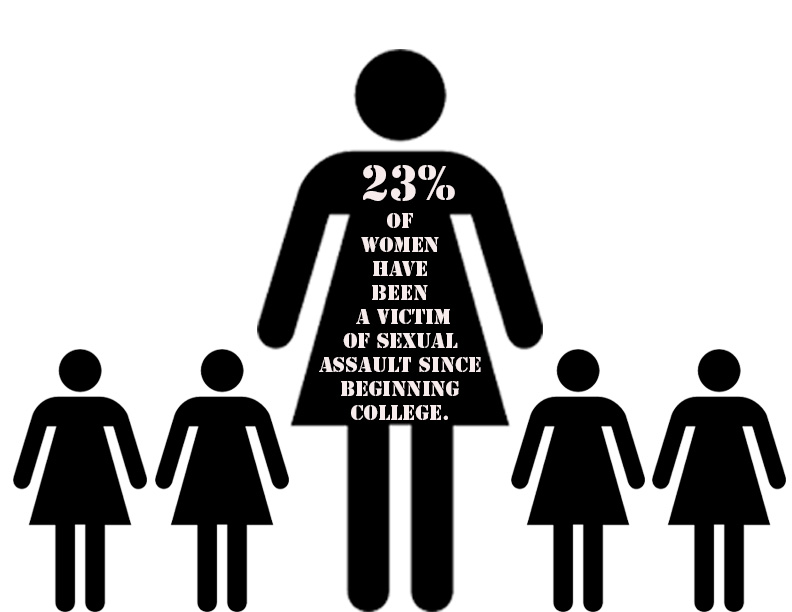Harmony Notman works full-time at Stonestown Galleria, only a short distance from her Village at Centennial Square residence on campus, but the walk makes her nervous.
Notman leaves her job in the evenings carrying pepper spray and wearing only one earbud, uneasy and worried about her physical safety due to recent incidents of sexual assault on campus.
There were 19 reports of sexual assault on campus between 2013 and 2015 — all but one incident occurred in the residence community, according to the 2016 Campus Security and Fire Report.
Notman said while she feels the University does well in its effort to inform students about sexual assault incidents and how to avoid and prevent them, she believes there is room for improvement.
“As far as the dorms go, I feel safe inside them knowing there are RAs (resident assistants) on the floor and always someone at the front desk,” Notman said. “But I do feel like there could be more security patrolling campus at night.”
According to the University Police Department’s “Timely Warning” page, the most recent sexual assault cases reported to campus police were in December, where the victim had met the perpetrator minutes earlier and again in January. This type of crime remains an issue despite University efforts to prevent them.
“Based on our experience, sexual assault and sexual violence can happen just about anywhere on campus, as well as off-campus,” said Luoluo Hong, SF State vice president and Title IX coordinator. “The most common denominator is that the respondent is usually somebody known to the complainant, or just recently met them.”
A campus climate survey of college students found that approximately 23 percent of females and 7 percent of males have been victims of rape or sexual assault.
The 2016 report by the Bureau of Justice Statistics Research and Development Series also found that sexual assaults often go unreported due to the crime’s personal and sensitive nature, the victim’s lack of confidence in a satisfactory outcome through the legal system, and at times, the victim failing to acknowledge that he or she was sexually assaulted.
A female SF State student, who preferred to remain anonymous, was sexually assaulted last semester near campus but is still undecided about whether to report the crime or not as she doesn’t know if it would lead to punishment.
“I’m in the process of still deciding whether or not to pursue it,” she said. “When it happened, his (perpetrator’s) roommate was there but they were friends since elementary school, so if I do pursue it I’m afraid that (UPD) aren’t going to believe me.”
The student said the incident also deepened her pre-existing anxiety condition and that she now takes prescribed medications for treatment.
“On most days, I can’t go to sleep without thinking about what happened,” she said. “I get panic attacks.”
Melissa Hagan, an assistant professor in the Psychology Department, said experiences of sexual assault can cause post-traumatic stress symptoms and even erosion of self-worth.
“It is not uncommon for the victim to feel guilty for ‘letting it happen’ or not fighting back harder,” Hagan said.
Hong said that university campuses have a duty to provide care and resources under the administration of Title IX, a federal regulation that primarily prohibits sex discrimination and sets sexual violence and harassment reporting requirements in academic environments.
The UPD works with Title IX coordinators by providing reports of sexual assault on campus as they happen, according to Deputy Chief Reginald Parson.
Parson said that campus police have tailored procedures in an effort to combat crimes such as sexual assault and to inform students and faculty about safety issues.
The UPD Community Liaison Unit looks at crime trends and statistics to develop informational presentations and documents focused on crime prevention and safety tactics for community members. The department plans to offer annual safety programs to students such as informational meetings and Coffee with a Cop events.
One program UPD is interested in pursuing is the “Safety Walk,” a program designed to inform students how to safely travel from one part of campus to another.
Many reports of sexual assault originate from residence communities, according to Parson. In response to sexual assault and other crimes on campus, Parson said UPD has worked to increase patrols in order to have a stronger presence.
SF State representatives responding to sexual assault victims are trauma-informed, according to Hong, which requires an understanding of the psychological and neurological trauma victims experience.
“We provide information about available resources and answer questions about the administrative investigation versus criminal investigation processes,” Hong said.
Hong said the Title IX department also encourages victims to seek medical treatment, crisis intervention and counseling support and offers students referrals to access support.
Title IX also works to protect the victim’s privacy, needs and preferences.
Parson said that while the UPD provides information on their “Timely Warnings” page about how to prevent sexual assault, there is difficulty in enforcing the measures.
“It’s kind of hard to say, ‘If you do this, if you do that, then you won’t be a victim of sexual assault,’” Parson said. “Really, the responsibility is with the suspect.”




